Alberto Savinio, Critic and Artist: A New Reading of Fantastic and Post-Metafisica Art in Relation to Surrealism Between Rome and New York (1943–46)
Giulia Tulino Giulia Tulino Alberto Savinio, Issue 2, July 2019https://www.italianmodernart.org/journal/issues/alberto-savinio/
This paper explores the establishment and reception of Italian “fantastic” art. Together with Raffaele Carrieri, Alberto Savinio first coined this term in 1940 to describe the process by which artists drew inspiration from ancient Greek and Mediterranean (rather than Romantic) artistic traditions. “Fantastic” art arrived in New York via Italian Peace Corps volunteer Peter Lindamood. Between 1945 and 1946, Lindamood promoted the term “fantastic Italian art” in American magazines as well as spaces such as the Hugo and Julien Levy galleries. The culmination of this public recognition was MoMA’s 1949 exhibition “Twentieth-century Italian Art,” which included a section of so-called “Fantasts.”
In 1945, the American magazine Town & Country featured an article by Peter Lindamood on the activities of Gaspero Del Corso and Irene Brin (the pseudonym of Maria Vittoria Rossi) – published just prior to their founding of the renowned L’Obelisco gallery in Rome.1 The account included the couple’s friendship with Alberto Savinio, whom they had first met in the 1930s while working for Omnibus, a magazine published by Leopoldo Longanesi. The friendship continued to grow during the years of the bookshop-gallery La Margherita, where Brin and Del Corso started working as art dealers in a Rome under German occupation.
Lindamood, a connoisseur of art and literature (figure 1), was enlisted in the United States Army as a member of the Psychological Warfare Branch—a special section reserved for journalists, writers, and photographers—and he took part in documenting the “cultural liberation” of Italy between 1944 and 1945. In vivid language, he described Rome and La Margherita, founded in 1943 by Federico Valli.
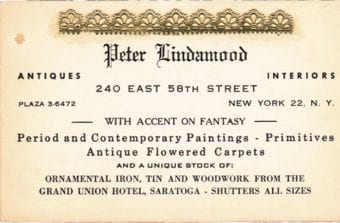
Del Corso himself would later describe Valli, in a 1978 interview, as: “A fascist but a person of culture, who during the regime used the funds of the Press Office of the Air Force to found a magazine, Documento. Periodico di attualità politica, letteraria e artistica, that in those lean periods gave to many writers and artists a breath of oxygen.”2 In these years, the term gran fascista (great fascist) applied to people who had not actually joined the regime but rather had helped, at personal risk, antifascist friends who needed jobs, economic aid, or a hiding place. Published monthly, Documento was a strange cultural container created in 1941 to keep Italians up-to-date on the political and military situation. This goal immediately took a turn as the magazine began to feature the literary and artistic fringe, with more and more space dedicated to culture, revealing Valli’s surprising network of knowledge (figure 2). The magazine presented the work of the majority of intellectuals of the time, and artists additionally contributed, a number of whom would become involved with La Margherita.

Documento’s columns were edited by emerging names of the capital’s cultural panorama: Enrico Falqui (books), Irene Brin (customs and practices), Luigi Bartolini and Libero de Libero (fine arts), Alberto Savinio (music), and Arrigo Benedetti (theatrical shows). Upon the magazine’s closing, in October 1943 – after the allied landing in Sicily in July, which led to the collapse of the Italian military in September – Valli opened La Margherita in Rome, at via Bissolati, number 12.3 Often referred to as a gallery, La Margherita was more precisely a bookshop-gallery. Savinio designed its beautiful signboard (figure 3).
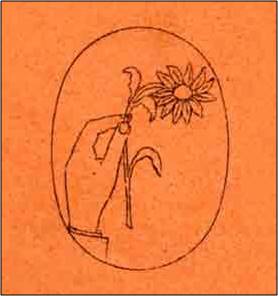
About La Margherita, Del Corso commented: “La Margherita was an antiquarian bookshop and gallery, but also an antifascist meeting center. They all came: Bartolini, Bragaglia, Guttuso, there was an extraordinary atmosphere of collaboration and friendship.”4 In the 1960s, Brin would write: “It was very small, without light or water, and to make a little tea it was necessary to cross the street and go and stand in line at the fountain in front” (figure 4).5
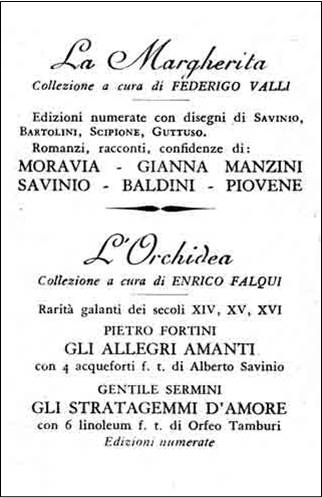
Brin was chosen by Valli (at the suggestion of Longanesi) to manage La Margherita, and Del Corso, as her husband, was hired with her. As an officer he had refused the call of the Republic of Salò, and had changed his name to Ottorino Maggiore (Savinio chose the name for him; figure 5) to hide from the German army.6
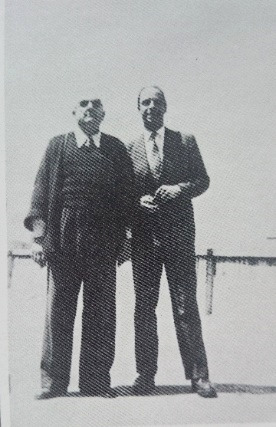
The bookshop-gallery sold books and valuable objects, and given the economic difficulties, some paintings owned by Del Corso and Brin. She wrote: “We joined a group of friends who, at Via Bissolati, wanted to sell what they still owned without going through intermediaries. This little shop was called La Margherita. Then with a small inheritance from my father, we started L’Obelisco, in Via Sistina.”7 L’Obelisco gallery opened in 1946 when the couple decided to work independently, having settled in Rome definitively. But their research into Savinio had started at La Margherita. In 1944, the gallery hosted, among its many initiatives, exhibitions of the artists Giorgio de Chirico, Gino Severini, and Orfeo Tamburi. In 1945, shows were organized of Renzo Vespignani, Franco Gentilini (presented by de Chirico), Savinio, and, again, de Chirico (presented by Jean Cocteau) (figure 6).
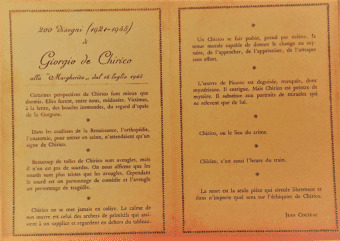
The bookshop-gallery also published special editions illustrated by artists, among them Savinio’s beautiful version of Gentile Sermini’s seventeenth-century book Stratagemmi d’amore (Stratagems of love, 1944; figures 7–11).
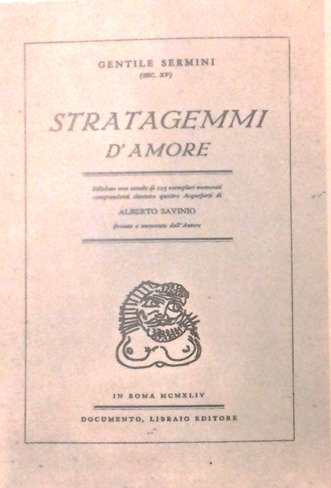
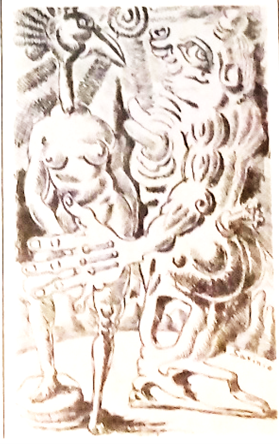
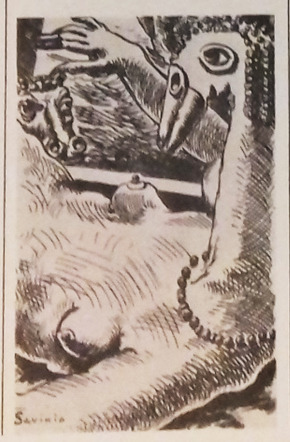
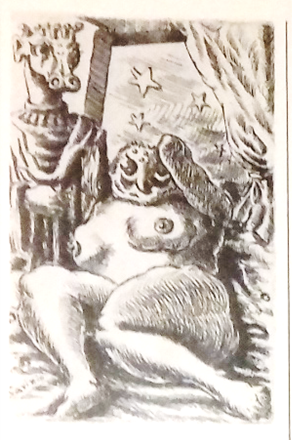
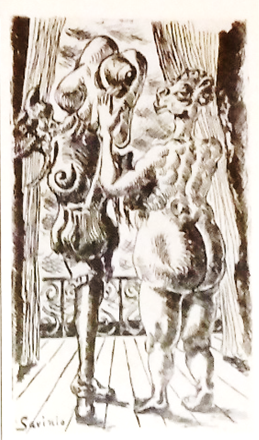
Archived documentation of activities at La Margherita shows interesting connections between Rome’s pre- and post-Liberation intellectual environments, specifically in how artists, writers, and critics were addressing the metaphysical and surrealism.8 La Margherita was evidently a space that presented Italian and foreign artworks with a strong tendency towards the fantastic and the surreal. The surrealist line that would later be identified with exhibitions at L’Obelisco gained momentum in these years.
Savinio, together with Raffaele Carrieri, was among the first to legitimize in Italy what could be called a “fantastic Italian art trend,” based on reminiscences of ancient Greece and rooted in the Mediterranean tradition instead of Romanticism. Carrieri, in 1939, wrote Fantasia degli Italiani (Fantasy of the Italians),9 which was pivotal in critically differentiating between surrealism and Italian art: the book was not an anthology of surrealist art, but an attempt to historically reconstruct a fantastic tradition in Italian culture (figure 12). This “fantastic Italian art trend” was supported by the theoretical writings of intellectuals including Mario Praz, Carlo Bo, Emilio Servadio, Giancarlo Vigorelli, and, as of the 1950s, Arturo Schwarz; as a result, an overlooked art history was reconstructed. The influence of French surrealism in Italy had long been hampered by Italian critics, mainly for two reasons: firstly, because of fascist censorship; secondly, due to a misreading of Romanticism and Nordic culture. Schwarz would be the first to point out the limits of Benedetto Croce’s reading of German Romanticism.10
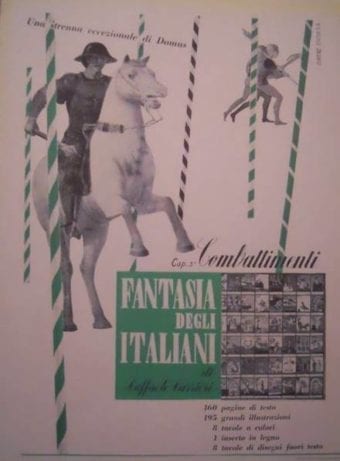
Over Marx, the occult, the esoteric, and psychoanalysis, Italians preferred rooted ideas from the past: classical thought, the mystique and nature of reality, religion, and idealism. In character they were very different from the associations of French artists, for instead of strange-natured men cursedly exploring the darker aspects of human complexity, Italians were dedicated to their work and individuality. What could be called an “Italian surrealist fréquentable” was a junction with a “return to order” that sought to rebuild, and not destroy, the Italian tradition.
In January 1940, Giancarlo Vigorelli along with intellectuals including Praz and Savinio published a series of essays in a surrealism-dedicated issue of Prospettive, a magazine under the direction of Curzio Malaparte (figure 13).11 These essays’ critical review of the French movement and its limits clarified the relationship between surrealism – as a modern movement closely connected to France – and Italian literature and art. For Vigorelli, the first point to make was that the origin of the word surrealism was not French but rather Greek, and then Italian. Moreover, the surrealist movement was young compared to the tradition of the “fantastic” that was typical of European Romanticism. Savinio, in writing for the figurative art supplement to Prospettive, continued along the same lines as Vigorelli, claiming:
In Italy surrealism is nature and the Italian surrealist tries to escape historical, moral, and aesthetic compromises because he wants to react to logic without taking refuge in unconscious freedom and irresponsibility or in the Freudian mechanisms, but instead to draw from imagination in a disinterested way in relation to logic and reason, conscious of a magically invented reality and not inherited by experience, tradition, or style.12
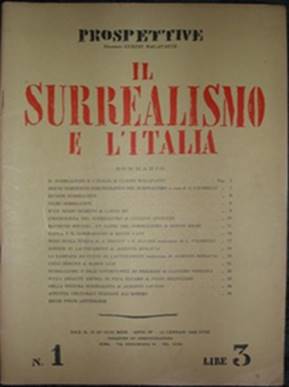
In January 1945, following this critical line, Del Corso and Brin organized an exhibition at La Margherita entitled Opere recenti di Leonor Fini, A. Beloborodov, F. Clerici, S. Lepri, A. Savinio, T. Zancanaro e Antiche Fantasie della Collezione Fiorini (Recent works by Leonor Fini, A. Beloborodov, F. Clerici, S. Lepri, A. Savinio, T. Zancanaro and antiques from Fiorini Collection; figure 14).
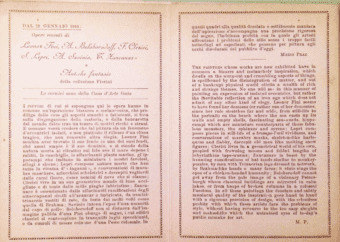
It was focused on Leonor Fini, then considered the leader of the Italian surrealists. In 1949, she would appear in this light again in the catalogue for the exhibition Twentieth-century Italian Art at the Museum of Modern Art in New York, for which the curators Alfred H. Barr Jr. and J. T. Soby invented the word “fantasts” (fantastici) to describe the Italian surrealist group. At MoMa, the “fantasts” included Fini, Fabrizio Clerici, Stanislao Lepri, and Giuseppe Viviani (figures 15–16). In his diary, Del Corso recalled that Clerici did not want to be considered a surrealist, but rather a follower of the metaphysical school and particularly of Alberto Savinio.13
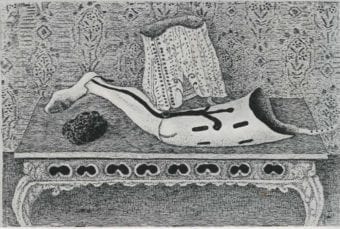
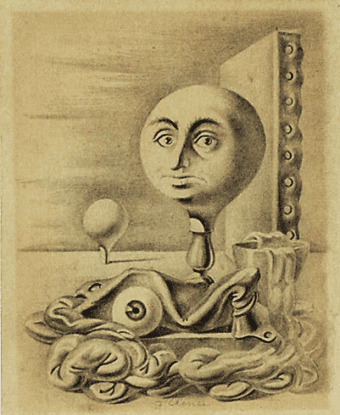
The opening of the exhibition at La Margherita sparked international interest among the denizens of the art world. Del Corse noted: “Some Americans are interested in the exhibited works but are amazed by the very high prices.”14 Between 1945 and 1946 many Americans were in Rome buying art, and particularly that of Giorgio de Chirico. Italy’s relationship with the US was important in these years – not surprisingly, the catalogue essay by Praz was written in Italian and English.15
In the late spring of 1945, La Margherita presented an exhibition Savinio’s art, as recalled here by Del Corso:
In May 1945, we organized the Savinio exhibition. Savinio had studied an original work for the outside gallery: a plaster cast of the bust of the Doriforo, totally colorful with abstract motifs as lines and little circles with no naturalistic colors. Savinio said that the classical Greek sculpture was completely painted, and in the abstract way, and he had settled the bust above the front door as a statue. The paintings, about ten, were exhibited in the little space of the gallery. There were more portraits, among them those of Irene Brin and Palma Bucarelli. The exhibition was a success, as were all his exhibitions in Rome, because even if Savinio was not considered a painter he was very loved and respected. His painting at that time was too literary and surrealism was considered outmoded, but his works were an homage and one way to stem the invasive tide of neo-cubism. Savinio had a provocative power also, because during his exhibition the gallery had the only incident in its history: one night some strangers broke the showcase where there was a Savinio painting, but without stealing it. Probably they were annoyed by the image represented, a woman with an animal head [figure 17].16
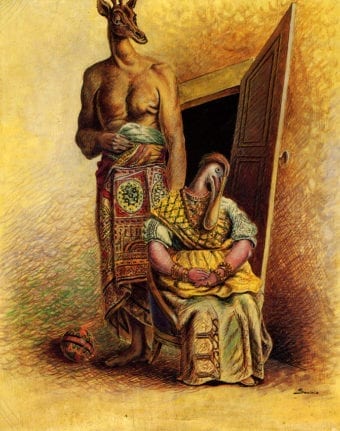
In his diary around this time Del Corso mentioned the article by Lindamood in Town & Country that describes La Margherita. The article turned out to be an important document in understanding postwar relations with the US in the diffusion of the “fantastic Italian art trend.”
Lindamood wrote for several US newspapers and magazines; among the most famous were Vogue and Harper’s Bazaar, and he was also a contributor to View, the magazine of surrealist settings (figures 18–20). He had worked with the art dealer Julien Levy and, in 1936, had met Leonor Fini and Giorgio de Chirico in New York. Earlier that year both artists had exhibited their works at Levy’s gallery, and they were in New York for the big exhibition Fantastic Art, Dada, Surrealism, organized by Barr and Soby at the Museum of Modern Art.17 In 1945, after Fini moved to Rome, Lindamood was her guest at Palazzo Altieri, together with Savinio, Praz, Stanislao Lepri, Fabrizio Clerici, and other intellectuals and artists. Through this group, loosely connected to surrealism, Lindamood also met Brin and Del Corso.
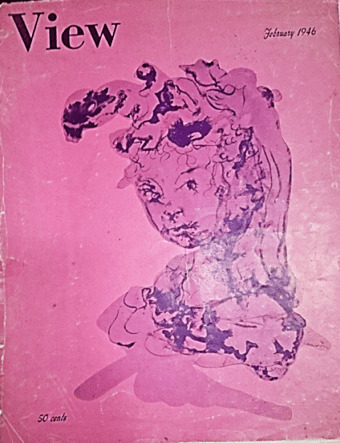
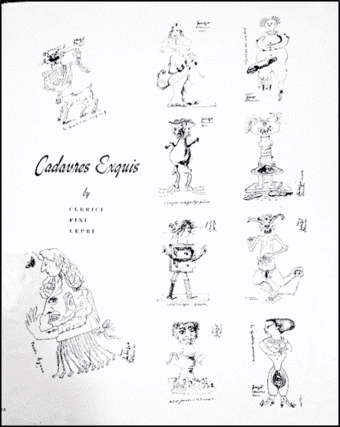
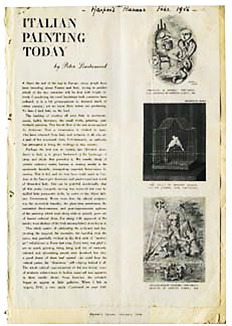
Over time Lindamood would prove important to the art market as a mediator between Italy and New York, and perhaps most interesting was his attempt to sell the “Italian fantastic and surreal art” that he had seen in the exhibitions of Savinio and other Italian surrealists at La Margherita. In fact, his Town & Country article recounts the enthusiasm of Brin and Del Corso for those works. Lindamood was particularly appreciative of the editions published by La Margherita, with significant examples being Agostino (1943) by Alberto Moravia, Forte come un leone (Stron as a lion, 1944) by Gianna Manzini, and La nostra anima (Our soul, 1944) by Savinio.
The atmosphere of the gallery, noted Lindamood, was international, for example the public could find magazines such as Life, Harper’s Bazaar, The New Yorker, and Vogue. In various articles Lindamood discussed at length the artists that he met in Italy, such as Fini, Lepri, Clerici, and Viviani. He was able to buy their works, which he then presented to Levy in New York. It was at the Julian Levy Gallery that he organized an exhibition in 1945 of Clerici and Viviani’s work (figures 21–22).18 Soon after, Del Corso recorded the arrival of a telegram from New York in his diary
A telegram arrived from America, from a man named [Alexander] Iolas, a Greek man, announcing the opening of the Hugo gallery, directed by the duchess of Gromont, previously married to Mister Gromont and now with Jean Hugo, surrealist and descendant of Victor. Iolas asked me about works by Leonor Fini, Filippo De Pisis, Stanislao Lepri, and other Italian surrealists. It is clear that he has contacted me through Peter Lindamood.19
This telegram confirms the recognition of an Italian surrealist line promoted by Del Corso and Brin at La Margherita, prior to L’Obelisco.
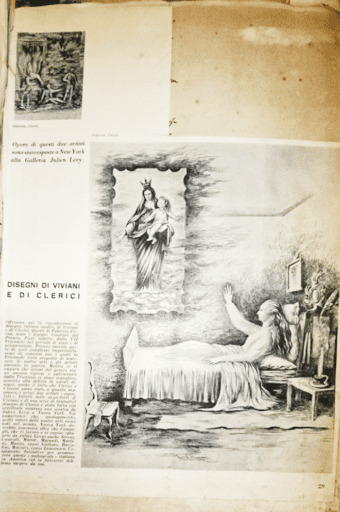
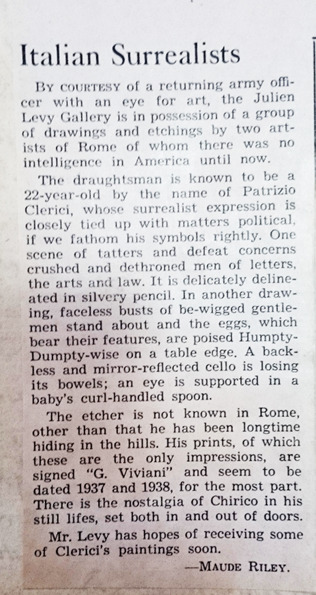
In 1946, Lindamood continued to advocate for “Italian Fantastic Art”: in an issue of View dedicated to Italian surrealism,20 he called out the artists being exhibited at La Margherita; and for Harper’s Bazaar he wrote an article entitled “Italian Painting Today.”21 In the latter, he wrote that the idea of regime art conjured ideological figures, trivial works, and sculptures – obsolete techniques with kitsch results. But in Italy, in the small galleries, a real artistic revival had begun with the end of the war:
When I left in August 1945, the Italian public was revitalized and had seen not only its first Picassos, Dalìs, Cocteaus, Ernsts, etc. […], but was awakening to the startling virtues of its great native individualists virtues of whom had been overlooked or arbitrarily under valuated. Outstanding among this latter group were Leonor Fini, Fabrizio Clerici, Stanislao Lepri, Antonio Donghi, Renzo Vespignani and Giuseppe Viviani. The works of these painters remind us that the fantastic, the elegant, the technically polished, and the progressively traditional in painting have not disappeared for the country which such values for centuries.22
The article goes on to list the artists Lindamood had met in Italy, among whom he considered the best to be Massimo Campigli, Giorgio Morandi, and Filippo De Pisis. About the “fantastic Italian trend” he wrote:
Gianfilippo Usellini paints with a great individuality in the general category of his prototypes Vivin and Bombois. The elderly Tono Zancanaro was for a long while feared dead, his superb anti Mussolini etchings some tears back having put a price on his life. The decline of Giorgio de Chirico is common knowledge by now, and his wonderful painter musician writer brother Alberto Savinio, writes far, far better than he paints.23
In New York, this interpretation of Giorgio de Chirico had arrived through the critique of André Breton and J. T. Soby’s declaring him, in the book After Picasso, a “young decayed genius.”24 Soby wrote of a new generation of artists, trained in Paris and showing at the Julien Levy Gallery, very famous in the USA at that time – among them Salvador Dalí, Max Ernst, the Berman brothers (Eugène and Leonid), and Pavel Tchelitchew. They would later show their works at L’Obelisco.
Lindamood invested in these Italian artists also because of the fertile soil that surrealism found in New York and in the USA, both in terms of critics’ favor and in the art market, contrary to what was happening in Italy, at least until 1954 when Savinio was given a retrospective at the Venice Biennale. Alberto Savinio and Giorgio de Chirico had putatively fathered the current of young artists designated as the “Italian fantastic art trend” – it is correct to celebrate and acknowledge their important critical contribution in Italy and beyond.
Bibliography
Barr, Alfred H. Jr., ed. Fantastic Art, Dada, Surrealism. New York: Museum of Modern Art, 1936. Exhibition catalogue.
Bo, Carlo. Antologia del surrealismo. Milan: Edizioni di Uomo, 1944.
Brin, Irene. L’Italia Esplode. Diario dell’anno 1952. Edited by Claudia Palma. Rome: Viella, 2014.
Braun, Emily. De Chirico and America. New York: The Bertha and Karl Leubsdorf Art Gallery at Hunter College, 1996. Exhibition catalogue.
Cavallo, Luigi. Primi aspetti del surrealismo in Italia. Milano: Galleria d’arte Cocorocchia, 1971.
Celant, Germano, and Anna Costantini. Roma–New York 1948–1964. Milan: Edizioni Charta, 1993.
Carrieri, Raffaele. Fantasia degli italiani. Rome: Editoriale Domus, 1939.
Carrieri, Raffaele. Pittura scultura d’avanguardia in Italia 1890–1950. Milan: Edizioni della Conchiglia, 1950.
Castronuovo, Antonio, Mauro Chiabrando, and Massimo Gatta. Federigo (Ghigo) Valli. Un protagonista rimosso dell’editoria italiana del Novecento. Macerata: Biblohaus, 2015.
Del Corso, Gaspero, “Storia di una galleria.” In Galleristi a Palazzo, edited by Italo Mussa, Augusta Monferini, Arnaldo Romani Brizzi, et al. Rome: De Luca, 1988.
Fagiolo Dell’Arco, Maurizio, Daniela Fonti, and Pia Vivarelli. Alberto Savinio. Rome: De Luca Editori, 1978. Exhibition catalogue.
Ford, Charles Henri, ed. View: Parade of the Avant-Garde. New York: Thunder’s Mouth Press, 1991.
Fusani, Claudia. Mille Mariù, la vita di Irene Brin. Rome: Castelvecchi, 2012.
Lindamood, Peter. “Italian Painting Today,” Harper’s Bazaar, February 1946 [page numbers could not be read.]
Lindamood, Peter. “Rome,” Town & Country, March 1945, [page numbers could not be read.]
Massau Dan, Maria. Leonor Fini. L’italienne de Paris. Trieste, Civico Museo: 2009. Exhibition catalogue.
Monelli, Paolo. Roma 1943. Turin: Einaudi, 2012.
Palma, Claudia. Fondo Irene Brin, Gaspero del Corso e l’Obelisco, edited by Claudia Palma and Simona Pandolfi, inventary, vol. 1, no. 2; published as appendix in Belle arti 131, no. 1, 2012. Available online here.
Petrignani, Sandra. Addio a Roma. Vicenza: Neri Pozza, 2012.
Piermattei Masetti, Chiara. Roma: sotto le stelle del ’44. Storia, arte e cultura dalla guerra alla liberazione. Follonica: Zeffiro, 1994.
Sauvage, Tristan. Pittura Italiana del dopoguerra (1945–1957). Milan: Schwarz Editore, 1957.
Savinio, Alberto. “Esiste un surrealismo italiano?” Prospettive, no. 1, 1940: 11–13.
Soby, James Thrall. After Picasso. Hartford, CT: E. V. Mitchell; New York: Dodd, Mead & Company, 1935.
Vigorelli, Giancarlo. “Il surrealismo e l’Italia.” Prospettive, no. 1, 1940: 20–22.
How to cite
Giulia Tulino, “Alberto Savinio, Critic and Artist: A New Reading of Fantastic and Post-Metafisica Art in Relation to Surrealism Between Rome and New York (1943–46),” in Alberto Savinio, monographic issue of Italian Modern Art, 2 (July 2019), https://www.italianmodernart.org/journal/articles/alberto-savinio-critic-and-artist-a-new-reading-of-fantastic-and-post-metafisica-art-in-relation-to-surrealism-between-rome-and-new-york-1943-46/, accessed [insert date].
- Peter Lindamood, “Rome,” Town & Country, March 1945.
- Quoted in Chiara Piermattei Masetti, Roma: sotto le stelle del ’44. Storia, arte e cultura dalla guerra alla liberazione (Follonica: Zeffiro, 1994). All translations in this essay are the author’s.
- See Antonio Castronuovo, Mauro Chiabrando, and Massimo Gatta, Federigo (Ghigo) Valli. Un protagonista rimosso dell’editoria italiana del Novecento (Macerata: Biblohaus, 2015).
- Quoted in Piermattei Masetti, Roma: sotto le stelle del ’44, 164–65.
- Irene Brin, L’Italia esplode. Diario dell’anno 1952, edited by Claudia Palma (Rome: Viella, 2014), 55.
- See Maurizio Fagiolo Dell’Arco, Daniela Fonti, and Pia Vivarelli, Alberto Savinio (Rome: De Luca Editori, 1978).
- Brin, L’Italia esplode, 56.
- This research was carried out at Fund Irene Brin Gaspero Del Corso and L’Obelisco GNAM (Galleria Nazionale d’Arte Moderna e Contemporanea of Rome), Archivio Obelisco of Jaja and Natalia Indrimi, Rome, and Archivio Clerici, Rome.
- Raffaele Carrieri, Fantasia degli Italiani, [Rome]: Editoriale Domus, 1939.
- See Tristan Sauvage, Pittura Italiana del dopoguerra (1945–1957) (Milan: Schwarz Editore, 1957).
- Giancarlo Vigorelli, “Il surrealismo e l’Italia,” Prospettive, no. 1, 1940.
- Alberto Savinio, “Esiste un surrealismo italiano?,” Prospettive, no. 1, 1940.
- Gaspero Del Corso’s diary, 1945. Available at the Archivio Obelisco of Jaja and Natalia Indrimi, Rome.
- Ibid.
- Mario Praz, Opere recenti di Leonor Fini, A. Beloborodov, F. Clerici, S. Lepri, A. Savinio, T. Zancanaro e Antiche Fantasie della Collezione Fiorini (Rome: La Margherita, 1945).
- Quoted in Ibid.
- Alfred H. Barr Jr, ed., Fantastic Art, Dada, Surrealism (New York: Museum of Modern Art, 1936).
- See Maude Riley, Italian Surrealist (New York, 1945). The newspaper in which the article was published could not be identified since I only had access to a newspaper clipping in the Fabrizio Clerici’s diary inside his archives.
- Del Corso’s diary, 1945.
- View, no. 1, February1946.
- Peter Lindamood, “Italian painting today,” Harper’s Bazaar, February 1946. Unfortunately, I only had access to a newspaper clipping in the Clerici’s diary inside his archives, the number of pages could not be read
- Ibid.
- Ibid.
- James Thrall Soby, After Picasso (Hartford: E.V. Mitchell; New York: Dodd, Mead & Company, 1935).

